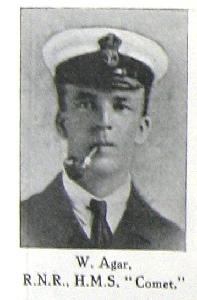
Agar, CERA W.C., 1918
William Charles Agar was the Chief Engine room Artificer on HMS Comet when she exploded whilst under tow. It was thought that she had been torpedoed. He was also an employee of the Smith Docks working at South Bank.
HMS Comet was an Acorn class destroyer of the Royal Navy that saw active service in the First World War. She was built under the 1909–1910 programme by Fairfield Shipbuilding & Engineering Company in Govan. She was launched on 23 June 1910 and lost after a collision while under tow on 6 August 1918 in the Mediterranean. Initially it was believed that she was torpedoed and sunk by an Austrian U-boat, but this was dismissed since no submarine claimed her sinking.
The Acorn class marked a return to oil-firing as pioneered in the Tribal or F class of 1905 and HMS Swift of 1907. This change allowed a generally smaller vessel than the Beagles even with an increase in armament. The Comet was built to an individual design by Fairfield Shipbuilding although the Acorns had a more-or-less uniform appearance, with three funnels, a tall, thin fore funnel, a short, thick central and a short narrow after stack. Comet had two 4-inch guns on the fo'c'sle and on the quarterdeck. The 12-pounder guns were amidships, one on each side between the first pair of funnels, and the torpedo tubes were abaft the funnels, mounted singly with a searchlight position between them.
Wilfred Charles Agar is remembered at North Shields on on N34.04 and N34.30, at South Shields on S86.004 and Harton on H104.01 and on our List of Ships’ crews

